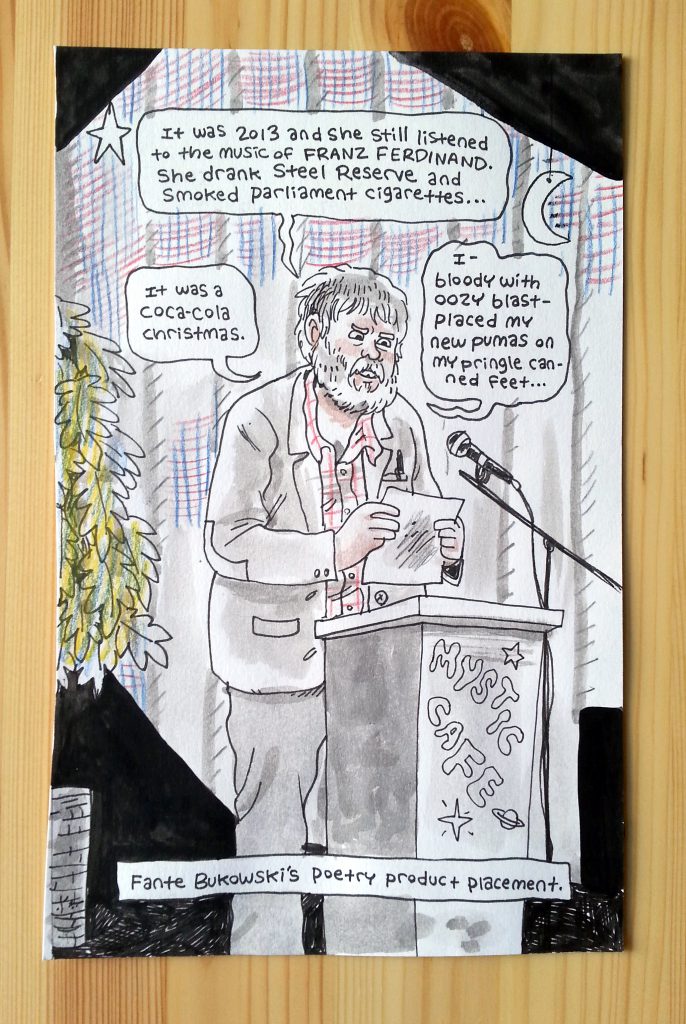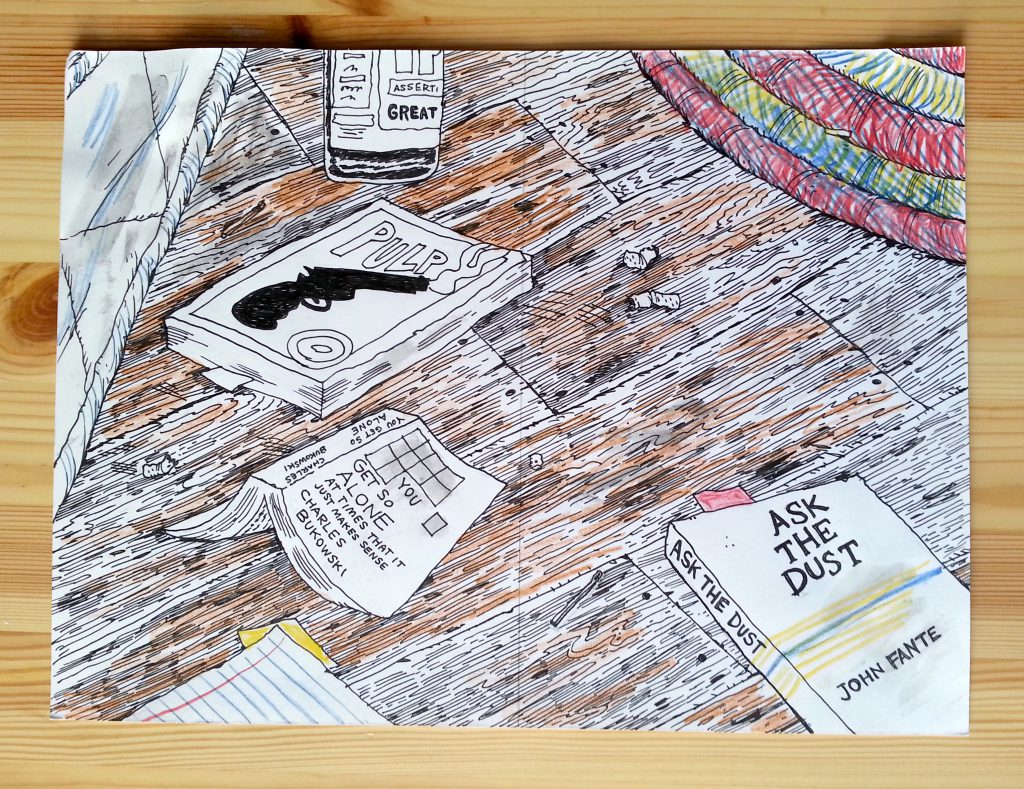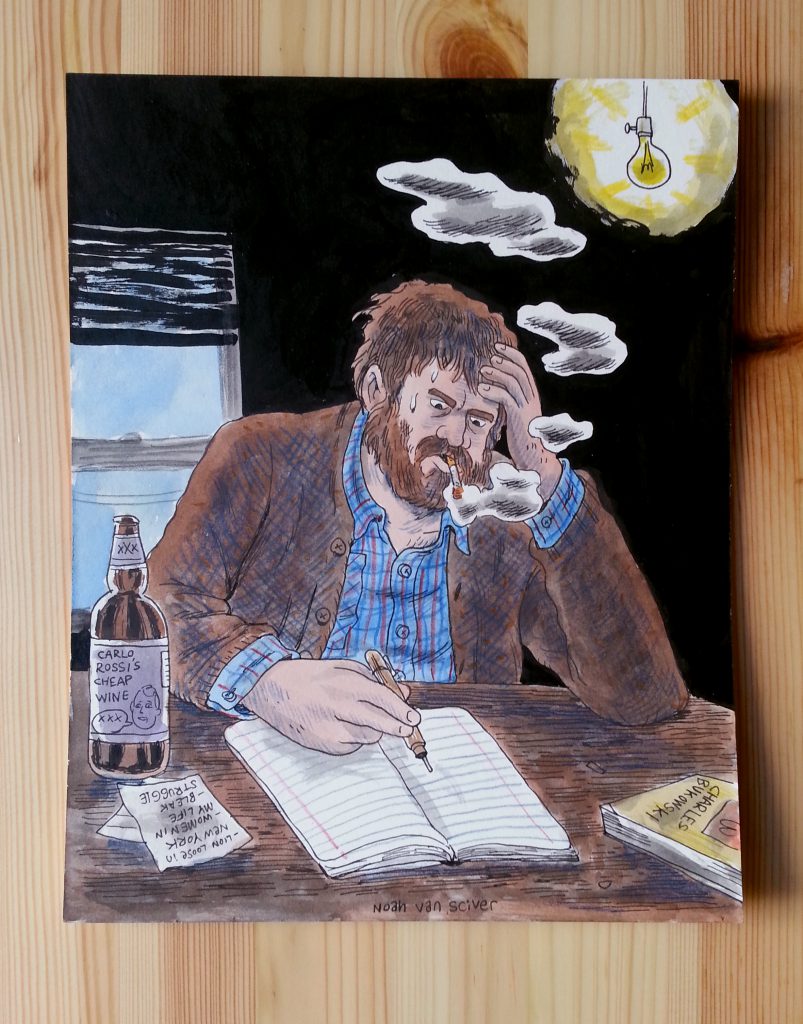Anna ManciniApril 29, 2016Scene ReportsHello!
This is Manzanna, or Anna Mancini. I’m a Brazilian freelance designer, illustrator and comics artist. I make zines, murals, t-shirt designs, animation, lettering and more – you can see my work on my tumblr and my website. I also have a facebook page, where I usually post my comics firsthand. Right now I’m managing client work, teaching a workshop on zines at the UFJF university and working on three new zines.
————————————————————————————————
Today, I’d like to talk to you about comics making in Brazil:
In the last couple of years, Brazilian comics have had quite an influx of new folks and initiatives, myself included; so let me walk you through some of the most exciting and relevant aspects of our scene in this report.
I am from Juiz de Fora. Home of the first television transmission in Latin America and of a widespread claim of inaugurating electric street light earlier than New York City (wrong by a year!), my hometown – Juiz de Fora, in the state of Minas Gerais, is not your first thought when it comes to Brazilian comics.
Most artists, publishers and events in Brazil are situated in state capitals like Rio de Janeiro, São Paulo, Brasília, Belo Horizonte and Porto Alegre so I wouldn’t blame you. Despite that, coming from an uneventful city didn’t stop me from working on my own stuff and getting in touch with other artists (thanks, internet).
I’ll start with my state in Brazil, Minas Gerais: our capital, Belo Horizonte, hosts the biannual International Comics Festival (Festival Internacional de Quadrinhos, or FIQ). With five days of panels, debates, workshops, exhibitions, it welcomes all sorts of enthusiasts, from the superhero fans to the more DIY, indie and experimental kinds. Every odd-numbered year, FIQ takes place in a historical lumberyard-turned-convention-center and proves itself as a great opportunity for attendees to meet in person with artists from different parts of the country, get to sell/buy/swap books + zines and hang out happily exhausted afterwards.
On a smaller scale, Belo Horizonte has a monthly fair called Faísca, which showcases not only comics but all things illustration and graphic arts.
Also from Belo Horizonte are the Lady’s Comics and ZiNas collectives, both committed to empowering women in comics; the former, a relevant content source on the topic, mobilized its first event in 2014 via crowdfunding and launched a magazine, Risca, in late 2015. ZiNas, in turn, are currently working on a project that includes a new book and free workshops on the subject of diversity in comics.
One of the ZiNas members, Aline Lemos, was featured previously on the Daily News section of the Comics Workbook website for compiling a collaborative list of all Brazilian women involved in comics, of all time. There are more than 400 names, an impressive number that contrasts with the often assumed lack of women in the field.
Other names that come to mind when talking about comics in BH are Ricardo Tokumoto, or Ryot, who makes lighthearted, funny, sometimes nonsense b&w strips, and Lu Cafaggi, who’s lending her super soft and expressive illustrations to a new release published by Nemo.
As not to neglect my hometown, here are local highlights from Juiz de Fora: Raphael Salimena, an illustrator and cartoonist with a dynamic, plymptoonian style who recently set up a Patreon to support his bi-weekly strips; and Ramon Vitral, a journalist currently based in São Paulo whose blog Vitralizado, about comics and pop culture, features insightful interviews with great names like Scott McCloud, Chris Ware and Liniers.
————————————————————————————————
In the southeast but towards the coast, there’s Rio de Janeiro.
There you can find the small indie publishing house A Bolha. With a staff of no more than 5 people, their passionate approach to publishing comes across with their well curated, intriguing and innovative books and warm newsletters. Among their staff is Gabriel Carvalho, who along with Mazô (this super talented young cartoonist) created Jornal Altamira, a newspaper-sized publication featuring comics by André Dahmer, L.M Melite, Fabio Zimbres, Alexandra Moraes and many others – it’s a stellar team.
If you want to read more comics from Rio, make sure to take a look at the diversified, often satyrical catalog by small publisher Beleléu; and the recently published Hermínia, a graphic novel by Diego Sanchez. His wiggly, charming drawings and stories quickly gathered online praise in the last couple of years, notably in his facebook page Quadrinhos Insones. ( Facebook, by the way, has played an important role for this new wave of comics in Brazil, allowing otherwise isolated self-publishers to reach numbers people unfamiliar to independent comics. Also from Rio and this facebook-driven scene is Tombo, curator of Zine XXX, an anthology of five 24-page zines from 2014 that jumpstarted comics by women in Brazil – it featured Laura Lannes, Bárbara Malagoli, Gabriela Masson (Lovelove6) and Sirlanney, to name a few.)
When it comes to events, there’s SIQ, the International Comics Week at the Federal University of Rio de Janeiro; Feira Pão de Forma, which gathers small publishers, artists and collectives (also produced by the folks from A Bolha); and with a similar premise is Feira Tijuana, a solid event at its 10th edition from São Paulo which is making its debut in Rio in May (days 7 and 8) at the insanely beautiful School of Visual Arts Parque Laje, located at the foot of the Corcovado mountain.
————————————————————————————————
Let’s talk São Paulo.
With its strong visual arts, publishing culture and centralizing tendency, the city is packed with collectives, artists and exhibitions. One can find comics and zines by Brazilian indie publishers events like: Kraft (at the State University of São Paulo), Avessa (at Sesc Pompeia), Miolo(s) (at the Mário de Andrade Library).
Miolo(s) is a production by the same folks of Lote 42, a small publisher of literature, poetry, careful & crazy formats and, yes!, comics. They’re also related to Banca Tatuí, a newsstand transformed into a pocket book shop at the heart of the city, where not only the works by Lote 42 can be found but also self-published, hand-made titles from other parts of the country.
The greatest, most anticipated independent event in SP, though, must be Feira Plana. Ever-growing, the latest edition offered, for the first time, a residency program and the next one is announced to happen at was it to be the largest venue to date, the Bienal of Ibirapuera.
Comics by women get the spotlight at Mina de HQ, an initiative by Gabriela Borges; also from the city is the hugely influential, outspoken genius Laerte Coutinho. Her son, Rafael Coutinho, also works in comics, being at the front of initiatives like A Nébula, an anthology of contemporary Brazilian comics, the book Teen Kiss and the publisher Narval. Collaborating with Narval there’s the talented Julia Balthazar, and since I’m dropping names, let me also recommend Puiupo, Wagner Willian, Pedro Cobiaco (from the publisher Mino), and still in the SP state but from the interior – Felipe Nunes and Amanda Paschoal.
Back to the city, you don’t miss a chance of visiting Ugra – a store, and an online shop and a publishing house that releases every year a comprehensive compilation of ibero-american zines.
————————————————————————————————
Now to Brasilia, closer to the actual geographical center of Brazil and capital.
From its number-named urban-planned streets comes a group of active, prolific comics artists such as Lucas Gehre, aka LTG, who makes a page everyday for his experimental, contemplative series Quadradinhas (he’s also part of the collective/magazine SAMBA); and Daniel Lopes, Augusto Botelho and João Diniz, who make MÊS, a series of zines published every month, with comics by themselves and open-call guests.
Worth mentioning again, more in-depth, is Gabriela Masson and her character Garota Siririca (something like Masturbation Girl). Defying taboos and misconceptions about sexuality, her story is updated every week at her website, which also sells sex toys. Gabriela is also part of the collective Batata Frita Murcha (Stale French Fries), along with Daniel Lopes and Heron Prado, that creates bummer stories on classic strip format. All the folks mentioned above, plus Selo Piqui and Extraterrestre, organize the event Dente, whose second edition happens in June.
————————————————————————————————
Despite often being underrepresented, northeast Brazil has been stirring with comics-related news.
There’s Felipe Portugal, from Piauí, who’s on a super fast pace releasing new strips for his series O Eremita (The Hermit); There’s Netuno Press, from the state of Ceará, which despite only having been launched recently has nine published titles under their belt and a consistent presence on events and fairs.
Events like GeekExpo and Tabuão are shaking up the scene, as are artists like Luiza de Souza, Éff, Sirlanney and Aureliano Medeiros, who all have published works at Tribo and have found caring audiences through social media. Tribo has also published Laura Athayde, originally from Manaus (North Brazil), an illustrator who makes funny strips about everyday life, but who transitions well to more somber themes in her longest stories.
Worth mentioning, too, is Ramon Cavalcante, a partner at Cosmic, a comics streaming service focused on independent Brazilian authors; creator of a very quiet, movie-like comics series called Inoffensive Comics and of a project that produced around 4000 screen-printed single-page comics that were offered in place of coin change at the local commerce in Fortaleza.
————————————————————————————————
At last, let’s talk about the South.
One of its states, Rio Grande do Sul, is home to Estúdio Complementares. This comics and illustration studio is formed by some really great names of comics in Brazil: Ana Luiza Koehler, author of the historical graphic novel Beco do Rosário; Cris Peter, colorist for Marvel and DC and Eisner nominee; Ariane Rauber and Ursula Dorada. They often teach comics and illustration classes at Galeria Hipotética, in Porto Alegre. The city also hosts its own indie publishing event, called Parada Gráfica – this year’s is going to happen in August.
Artists from Porto Alegre include Samanta Flôor, a freelance cartoonist who makes sweet, endearing comics; Chiquinha, whose work might remind you of a dirtier, more daring Maitena; Odyr, both a skillfull painter and synthetic cartoonist; Fefê Torquato and Giovana Medeiros. Curitiba, in the state of Paraná, often hosts book releases at the Itiban Comic Shop, as well as talks and debates. One of the latest featured was Estelle Flores, co-founder of Selva Press – one of the few risograph printing studios in Brazil.
————————————————————————————————
For more information on Anna Mancini, visit her online on her website, tumblr or her facebook page.
Share this page: [...]



